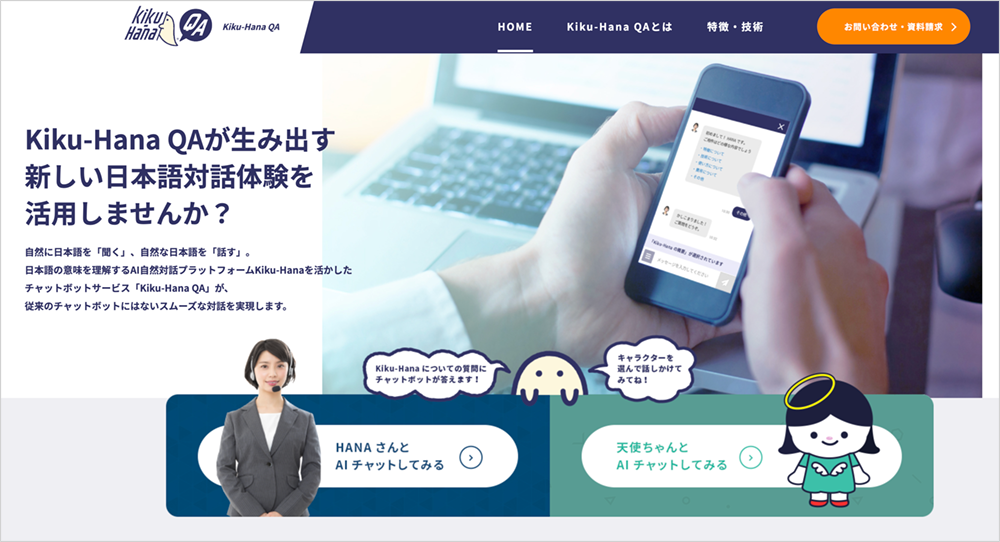Note: This website was automatically translated, so some terms or nuances may not be completely accurate.
ChatGPT brings renewed attention!? Corporate site chatbots are super-evolving with "AI × Character"!

Currently, the emergence of the conversational AI "ChatGPT" has heightened interest in AI chatbots.
However, the reality is that most chatbots seen on corporate websites are essentially impersonal, merely answering "frequently asked questions."
We believe chatbots hold significant potential to enrich communication between companies and users. The key lies in combining "AI" with "characters."
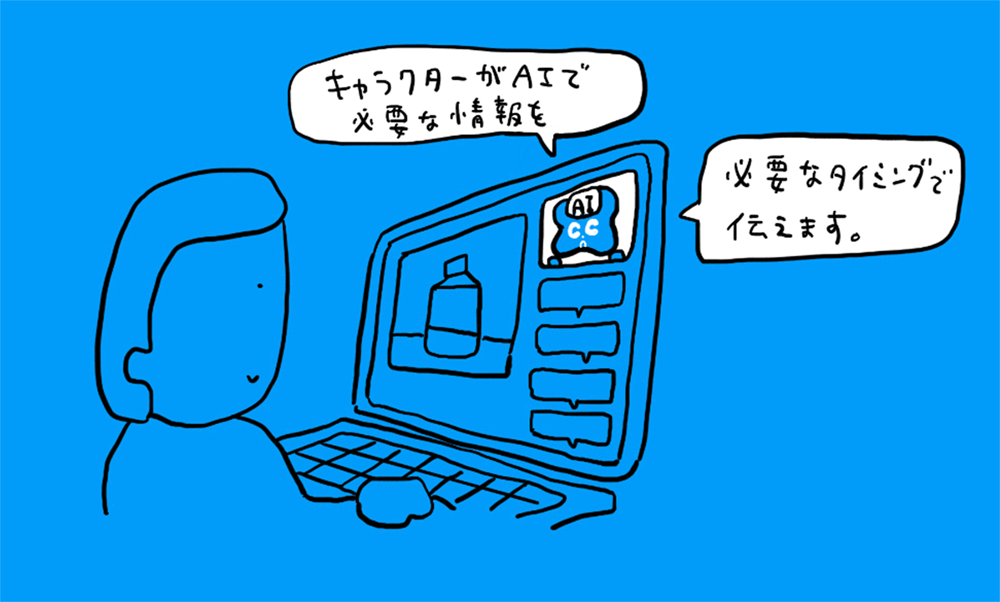
This time, we introduce "Chat Staff," a new product description service developed by Dentsu Inc.'s AI Chatbot Team, and the "Character AI Site," which adds characters to it.
Character CX Team's Kentaro Itomori sat down with Producer Hirotaka Arai, who led Chat Staff's development, to discuss the limitless possibilities of characters becoming a company's "face" and revolutionizing all customer experiences through technology!
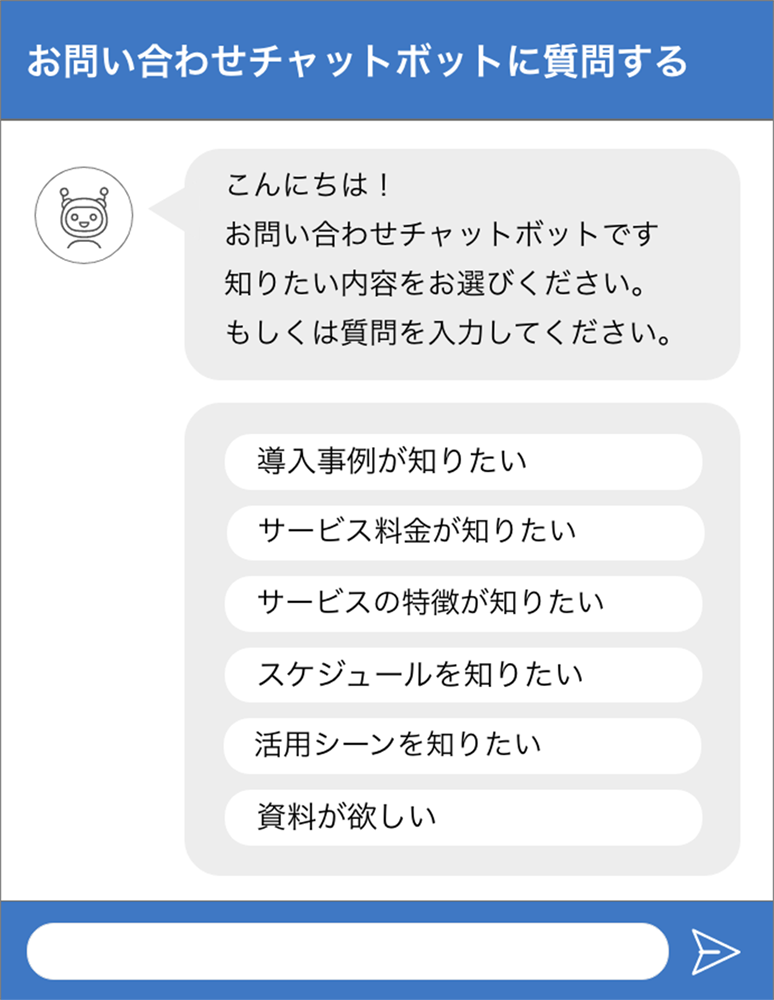
<TABLE of Contents>
▼Today's users want "only the necessary information, efficiently." But...?
▼Dentsu Inc.'s AI chatbot engine excels at "natural language processing"!
▼Using characters as the interface transforms the customer experience!
▼The essence of AI customer service is realizing "1-to-1 marketing"
Today's users want to "efficiently receive only the information they need." But...?

Itonori: Today, I'd like to dive deep into the potential of AI chatbots with Mr. Arai from the AI chatbot team that developed Dentsu Inc.'s new service, "Chat Staff"!
But first, let's have our readers watch the Chat Staff demo video. It's set on a fictional supplement website called "Folic Acid Supplement X."
Unlike traditional AI chatbots, Chat Staff can handle free-form chat and display supplementary videos or slides based on the answers to questions. Implementing it on a company's website offers benefits like improving usability and capturing valuable, honest user feedback about products.
Itonori: Now, I'd like to ask how Chat Staff differs from conventional chatbots and how its features contribute to corporate websites.

Arai: The key features of Chat Staff can be broadly categorized as follows:
- It can quickly and accurately provide the information users need right then and there, directly on the page they're viewing.
- It displays visual content like videos and slides to supplement information, not just text.
- It features a conversational design that allows for free-form user input (free answers), not just predefined FAQs.
In this demo video, in addition to the three points above, with the cooperation of Ms. Itonori's team, we have a character named "Yo-san," who personifies folic acid, responding in a fun and engaging way.
Itonori: We'll discuss the character later. For now, let's talk about each of the Chat Staff features you mentioned. First, "providing the information users need right now quickly and accurately within the page."
Arai: Chat Staff is a one-screen solution. Instead of overwhelming users with vast amounts of information and making them search for what they need, it displays videos and slides alongside text answers when users input questions in text form, enhancing their understanding of the product.
When companies create websites for their products or services, they often post tons of information. Sometimes a single product page spans dozens of pages. Plus, product pages often start with basic info like "Why is material X so good?" But some users already know the fundamentals beforehand.
Precisely because the internet is overflowing with information today, there's a strong demand for "quickly grabbing the desired information within limited time." This tendency is particularly strong among the younger generation, often called Generation Z, and also among older users who are highly proficient with the internet.
Itonori: Chat Staff addresses the need to "get only the points I want to know, clearly and immediately" by presenting the necessary information—including videos and slides—without requiring page transitions.
I believe most users today want information presented visually, like videos, for easy understanding. So the fact that it communicates not just through text, but also visually with videos and slides, is a major advantage.
Arai: On PC browsers, the left side is the presentation area and the right is the chat area. The presentation area displays supplementary videos or slides. For smartphones, it supports both portrait and landscape modes; in portrait mode, the presentation area is at the top.
Rather than having users search for information within the website, Chat Staff displays the requested information directly on the screen. Improving site navigation is a major goal of Chat Staff.
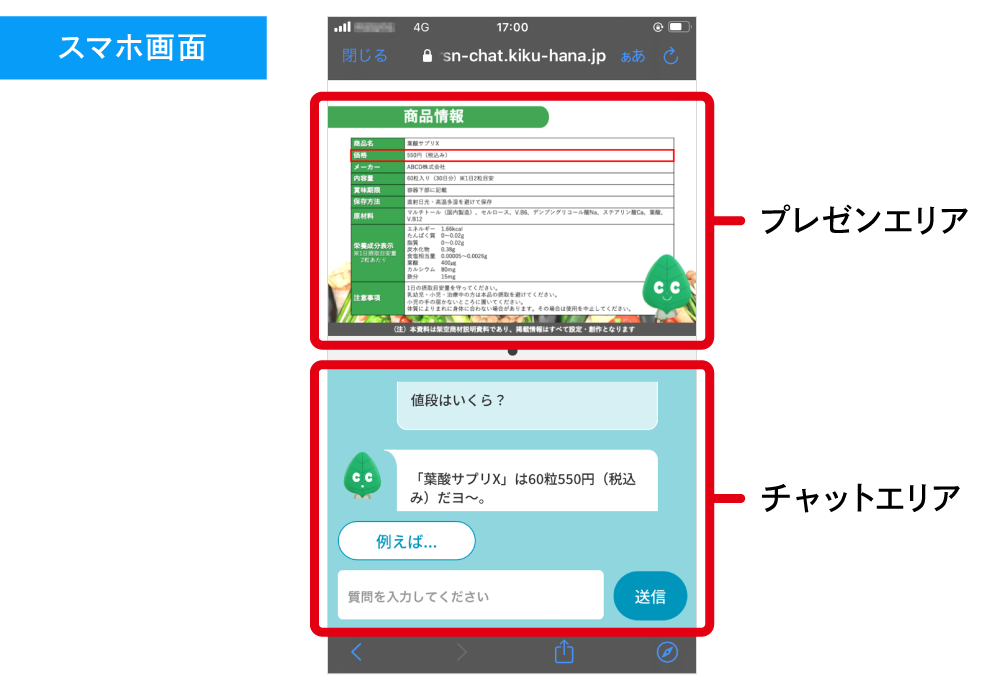
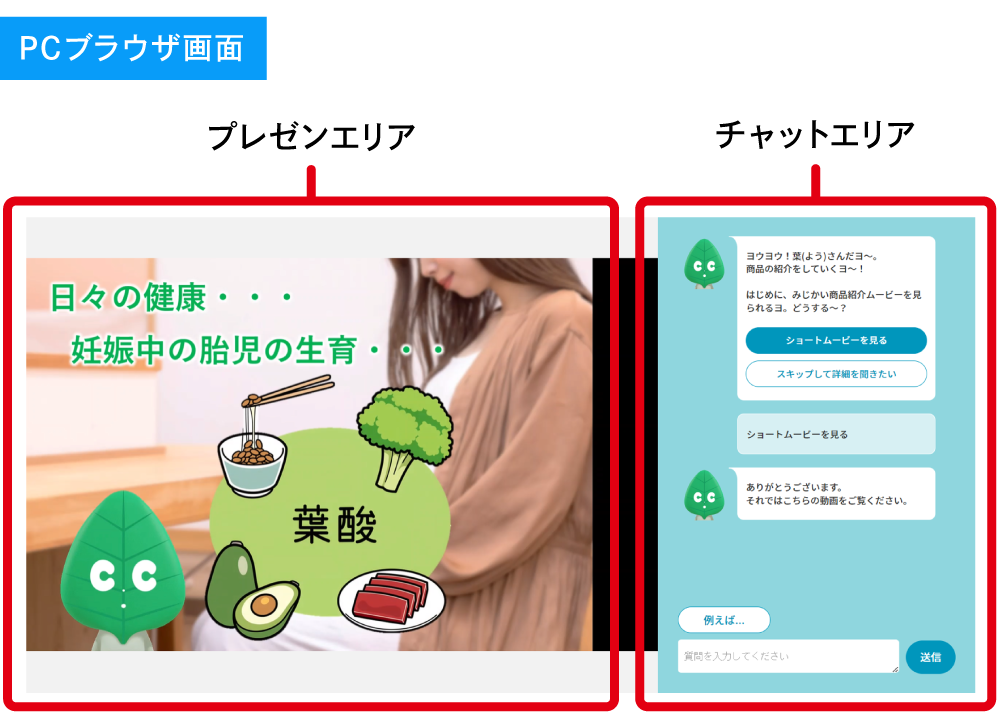
Itonori: It's a stress-free design because users don't have to go out of their way to find the information they want. They just ask a question on the spot, and the necessary information is instantly presented in text, video, slides, or other formats. Chat Staff was developed with a different concept than traditional chatbots. How has the actual user response been?
Arai: During Chat Staff's pilot testing, we surveyed users. Many said things like, "Having both videos and text chat makes me feel more confident about purchasing products." We also have data showing a 15% increase in product understanding and a 9% increase in purchase intent compared to traditional site navigation.
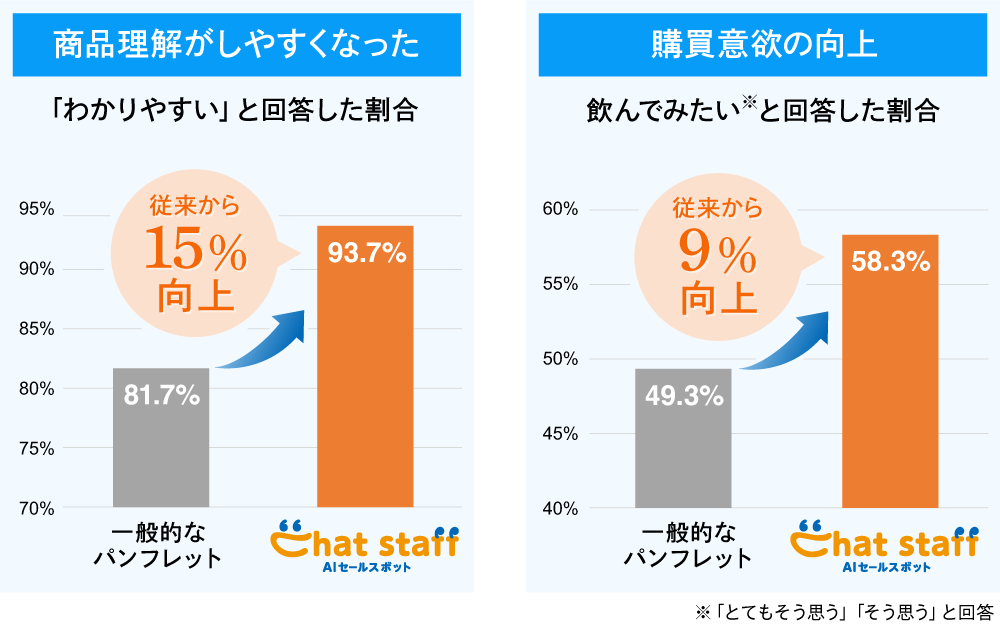
Itomori: 9% is significant. By the way, can users ask questions not just by typing but also by voice?
Arai: Yes, voice recognition can definitely be integrated. It depends on the customization. Furthermore, we can also "read aloud" the entire conversation text. By supporting voice chat, we can create a more enjoyable atmosphere through voice interaction and make it suitable for users who feel even slight resistance to keyboard input , expanding the service's potential.
Dentsu Inc.'s AI chatbot engine excels at "natural language processing"!
Itonori: Next, I'd like to ask about another major feature: free-form responses, or free answers. Chat Staff uses Dentsu Inc.'s AI chatbot engine, "Kiku-Hana," correct?
Arai: Yes. Dentsu Inc. released Kiku-Hana in 2018. Its greatest strength as a chatbot engine lies in its "natural language processing" capabilities—in simpler terms, its ability to understand Japanese.
While the emergence of ChatGPT and similar technologies might bring changes in the future, most chatbots currently used by companies tend to display a few pre-prepared options and ask users to "select the closest one." In other words, despite being called a chat, it often doesn't really involve much "dialogue" with the user. However, Kiku-Hana's high natural language processing capability allows it to understand the meaning of messages freely written by users and provide appropriate responses. This is the core development concept behind Kiku-Hana.
Furthermore, allowing free text input makes it easier to gain marketing insights—users' genuine, unfiltered thoughts, questions, and requests about products. Additionally, having a character serve as the interface tends to encourage users to converse more intimately. In the earlier survey, one comment noted, "It feels like there's a real person behind the scenes responding."
Itonori: Regarding "natural language processing," OpenAI's "ChatGPT" and Microsoft Bing are generating a lot of buzz, aren't they?
Arai: Yes. While companies using AI chatbots for customer communication can certainly leverage those technologies in some scenarios, I believe there are also many situations where meticulous design is required for the "communication the company wants to have with customers," and where the bot must operate precisely according to that design. In that sense, customer touchpoints between companies and consumers demand solutions like Kiku-Hana, which can be carefully designed and utilized down to the finest details. Within this division of roles, I expect we'll see more cases where companies choose one approach, or integrate both.
Itonori: Why did Dentsu Inc. decide to develop an AI chatbot in the first place?
Arai: Our team has long supported companies in implementing chatbots, but previously we relied on systems developed by other companies. However, working with chatbots inevitably makes you want to modify the platform itself.
For instance, we wanted to create user services that differed from the existing chatbot image, leveraging Dentsu Inc.'s unique creativity to the fullest. Or, since conversation data accumulates anyway, we wanted to store it in a way that could be leveraged to improve services and products. At that point, third-party services just didn't scratch the itch, so we decided to develop our own. Various chatbots using Kiku-Hana are covered in detail in another series.
[Series] The Future of Communication: Insights from AI Chatbots
https://dentsu-ho.com/booklets/283
Using Characters as Interfaces Transforms Customer Experience!
Itonori: Past Kiku-Hana proof-of-concept experiments often combined AI with characters. When designing UX, what are the benefits of "making characters the interface"?
Arai: The primary benefit is undoubtedly the ability to bridge the gap between users and the company (or the service being offered). From a customer engagement perspective, combining characters with AI chatbots offers significant advantages.
We position chatbots as one of the crucial contact points where users experience the company. While many companies now implement chatbots on their sites, they often give users an impersonal, mechanical impression. It's also difficult to differentiate from competitors, making services seem similar everywhere.
By using relatable characters as the interface, we can enhance brand and product favorability, improve product understanding and purchase intent, and increase the likelihood of sustained engagement.
Also, as mentioned earlier, when users can freely chat with a character, they might share not just simple questions but also casual concerns or frustrations. This presents a valuable opportunity for companies to gather important data.
Itonori: What kind of user insights can you discover through free-form input?
Arai: For a food product case, we got questions like, "When I recommend this to a friend, is there any incentive for me?" or about another product from the same company: "Is it okay to eat this with that?" These are needs companies never imagined, beyond what predefined options could capture. This can drive further product development and service improvements.
Itomori: I see! Our "Character CX" aims to provide consistent CX by placing characters at every user touchpoint, including AI chatbots. What do you think of Dentsu Inc.'s strengths when it comes to making characters touchpoints?
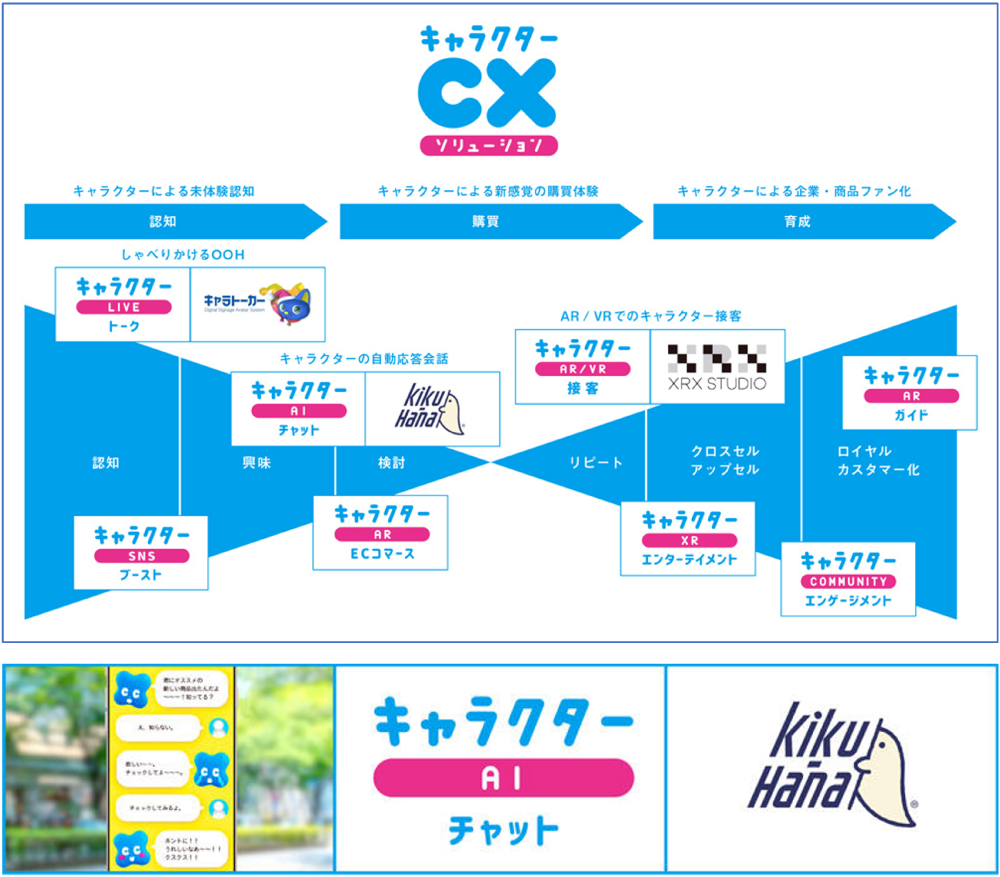
Arai: When developing characters, it's not just about visual design; defining the character's role and conversation tone is also crucial. Handling free-form input means we must properly design the communication and scenarios—specifically, what kind of responses to provide.
By involving copywriters and art directors, we go beyond just providing the chatbot engine. We offer a one-stop solution that includes communication design focused on the user's perspective and feelings, enabling us to deliver a better service. This is a unique selling point for Dentsu Inc.
We customize chatbots to align with each client's brand image and their specific "goals they want to achieve through the chatbot." At that point ( ), it's essential to design the communication with users based on a thorough understanding of the company and its brand.
The essence of AI customer service is realizing "1-to-1 marketing."
Itonori: How do you envision evolving this solution going forward? It would be interesting if we could achieve things like making the characters even more expressive or having their reactions change based on how many times a user visits the site.
Arai: By combining user psychology with technology, we want to evolve this into a solution that further smooths communication between companies and consumers.
Changing a character's expressions to match their spoken lines is precisely one such means. While technologically feasible, it's crucial to use it appropriately based on the purpose and to carefully design the dialogue settings.
If the goal is to create a chatbot that enhances customer engagement, having the character's reactions change based on the number of site visits is a very interesting approach.
Itonori: When you get personalized responses, it makes you want to chat more warmly. Sometimes it might even be fun if they shared totally unrelated info (laughs). Also, it would be great if they could recommend suitable information based on the user's age.
Arai: With current technology, we can estimate a user's age or analyze their emotions using facial recognition via a PC camera. Even without a camera, we could simply ask users their age via a survey and adjust interactions accordingly. In some cases, we could even prepare multiple characters.
Earlier, we mentioned linking with a company's member database. For example, on sites with a "My Page," having users log in enables communication optimized specifically for them. By the way, users can also directly request samples or purchase products from the item information displayed by the chatbot.
Itonori: So users can converse with the chatbot and complete the conversion right on that page! This also creates a stress-free site navigation experience.
Arai: At that point, we can also ask for details like the "delivery address" or "order quantity" right within the chatbot interaction. Traditional registration forms often create a high barrier—users think, "Wait, I have to fill out all this?" But when we ask all these questions seamlessly within the chat, people are more likely to respond.
It also makes obtaining permission (consent) easier. Checkboxes like "Allow phone contact" often struggle to get agreement. But if the chatbot communicates effectively and explains the benefits of receiving a call through videos or slides in the presentation area, customers are more likely to think, "Oh, in that case, I'm okay with them calling me," and give their consent.
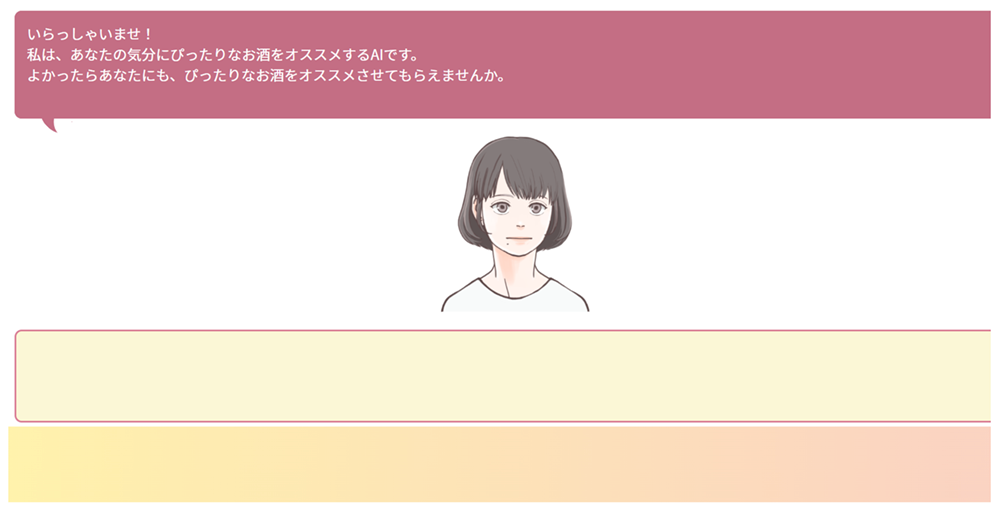
Itonori: I see. It feels like we're returning to the customer service era before television, where one-on-one communication is becoming more important now, whereas before, TV delivered the same information to many people. By incorporating AI, it's like we can infinitely perform "one-on-one customer service," similar to how a fishmonger sells fish to regular customers.
Arai: That's true. When we started Chat Staff, one team member said, "The essence of AI conversation is 1-to-1 marketing." 1-to-1 has long been discussed as an ideal form of marketing, but until now, it was difficult to achieve both technically and efficiently. I think we're finally getting close to making it a reality.
Itonori: When companies and users can communicate through conversations with AI, it seems like we could achieve a customer experience completely different from anything before.
Arai: Having a character with AI embedded makes conversations enjoyable and fosters affection for that character. That character then functions as the face of the company. Even in call centers, the impression of a company can change just based on an operator's tone of voice, right?
When pursuing chatbots that are easy for customers to use, the ideal form is really Doraemon, Astro Boy, or Samantha from the movie "her." I think having enjoyable conversations between machines and humans will become commonplace in the future.
Itonori: That really gets the imagination going! In the future, it seems like we'll be able to converse with AI characters not just on corporate sites, but across various media. What about in the currently trending metaverse, for example?
Arai: Within digital spaces, we can display Chat Staff's presentation area floating in the environment. This allows characters to behave as if they're projecting images or slides into the space to explain things.
Even beyond the metaverse, I think Chat Staff could be applied to station signage or any digital touchpoint. As characters communicating with humans becomes commonplace, the range of contact points will likely keep expanding.
While usability improves, I hope we can create a virtuous cycle where companies continuously enhance customer experiences based on the data they gather.
Itonori: Personally, I'd love it if conversing with AI characters to get information or communicating with companies becomes the norm in the future (laughs). Thank you for today!
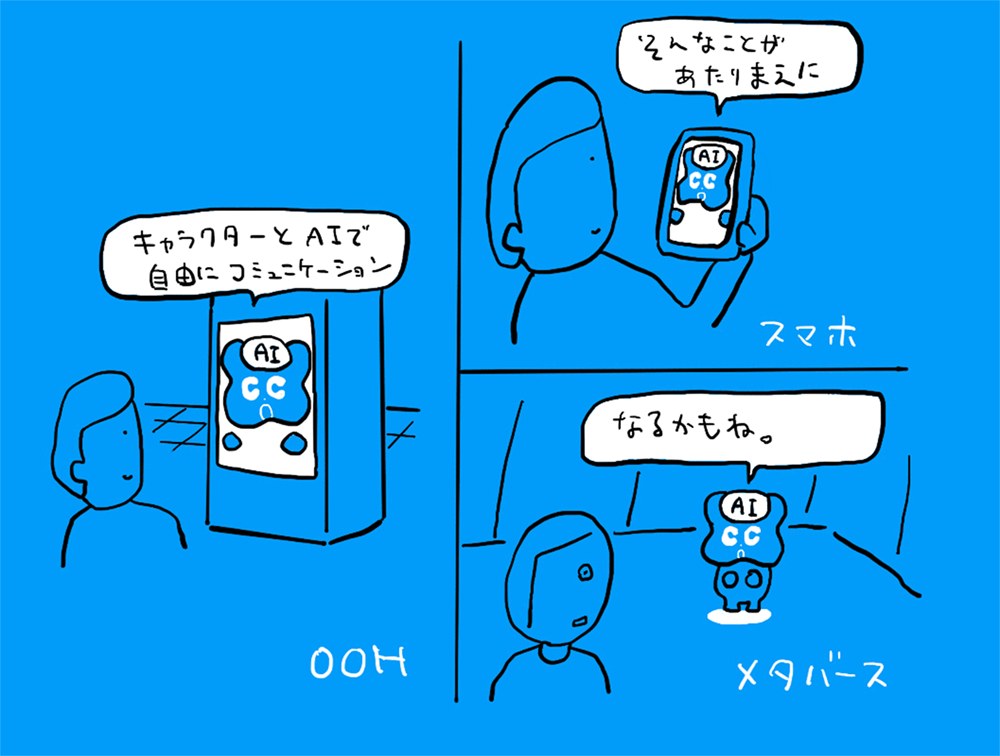
Was this article helpful?
Newsletter registration is here
We select and publish important news every day
For inquiries about this article
Author

Kentaro Itonori
Dentsu Inc.
Customer Experience Creative Center
Art Director
Leveraging characters for diverse communication applications. In 2021, launched the "Character CX Solution" that combines technology with characters to enhance customer experiences. Continues to explore new character applications. Representative developed characters include Ponta for the Ponta points service, Nanana for TV Tokyo, and DANCE-K for the D-League.

Hirotaka Arai
Dentsu Inc.
Business Co-creation Bureau
Communication Planner/Producer
At the Business Co-creation Division, I develop and operate Dentsu Inc. original AI conversational solution, "KiKu-Hana." I also engage in marketing support that leverages analysis derived from conversational data.
